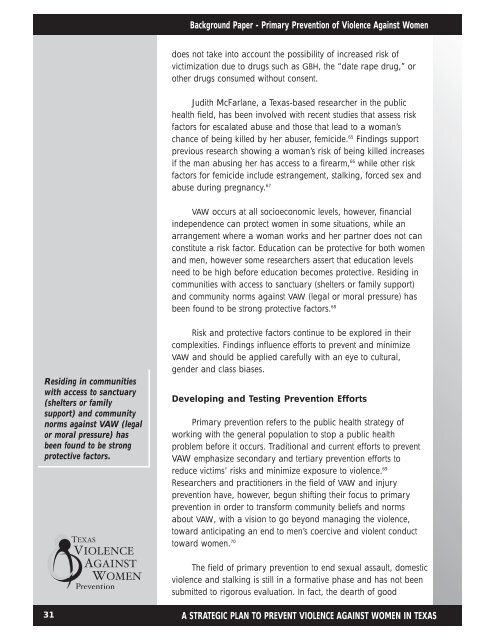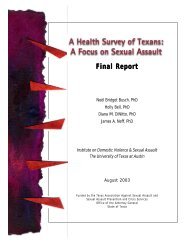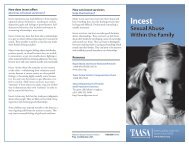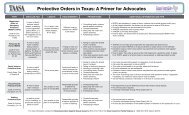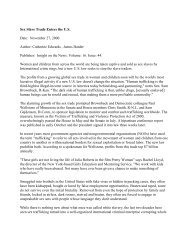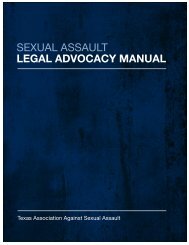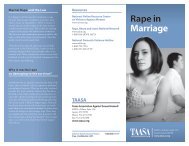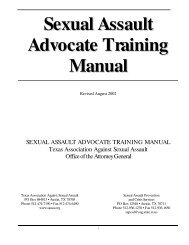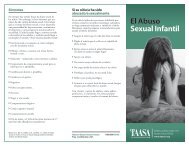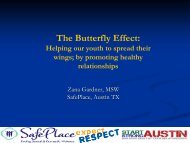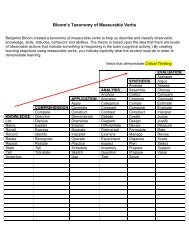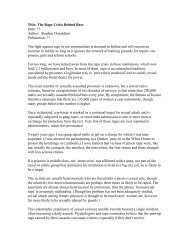TDH Booklet4 - Texas Association Against Sexual Assault
TDH Booklet4 - Texas Association Against Sexual Assault
TDH Booklet4 - Texas Association Against Sexual Assault
Create successful ePaper yourself
Turn your PDF publications into a flip-book with our unique Google optimized e-Paper software.
Background Paper - Primary Prevention of Violence <strong>Against</strong> Women<br />
does not take into account the possibility of increased risk of<br />
victimization due to drugs such as GBH, the “date rape drug,” or<br />
other drugs consumed without consent.<br />
Judith McFarlane, a <strong>Texas</strong>-based researcher in the public<br />
health field, has been involved with recent studies that assess risk<br />
factors for escalated abuse and those that lead to a woman’s<br />
chance of being killed by her abuser, femicide. 65 Findings support<br />
previous research showing a woman’s risk of being killed increases<br />
if the man abusing her has access to a firearm, 66 while other risk<br />
factors for femicide include estrangement, stalking, forced sex and<br />
abuse during pregnancy. 67<br />
VAW occurs at all socioeconomic levels, however, financial<br />
independence can protect women in some situations, while an<br />
arrangement where a woman works and her partner does not can<br />
constitute a risk factor. Education can be protective for both women<br />
and men, however some researchers assert that education levels<br />
need to be high before education becomes protective. Residing in<br />
communities with access to sanctuary (shelters or family support)<br />
and community norms against VAW (legal or moral pressure) has<br />
been found to be strong protective factors. 68<br />
Residing in communities<br />
with access to sanctuary<br />
(shelters or family<br />
support) and community<br />
norms against VAW (legal<br />
or moral pressure) has<br />
been found to be strong<br />
protective factors.<br />
Risk and protective factors continue to be explored in their<br />
complexities. Findings influence efforts to prevent and minimize<br />
VAW and should be applied carefully with an eye to cultural,<br />
gender and class biases.<br />
Developing and Testing Prevention Efforts<br />
Primary prevention refers to the public health strategy of<br />
working with the general population to stop a public health<br />
problem before it occurs. Traditional and current efforts to prevent<br />
VAW emphasize secondary and tertiary prevention efforts to<br />
reduce victims’ risks and minimize exposure to violence. 69<br />
Researchers and practitioners in the field of VAW and injury<br />
prevention have, however, begun shifting their focus to primary<br />
prevention in order to transform community beliefs and norms<br />
about VAW, with a vision to go beyond managing the violence,<br />
toward anticipating an end to men’s coercive and violent conduct<br />
toward women. 70<br />
The field of primary prevention to end sexual assault, domestic<br />
violence and stalking is still in a formative phase and has not been<br />
submitted to rigorous evaluation. In fact, the dearth of good<br />
31 A STRATEGIC PLAN TO PREVENT VIOLENCE AGAINST WOMEN IN TEXAS


